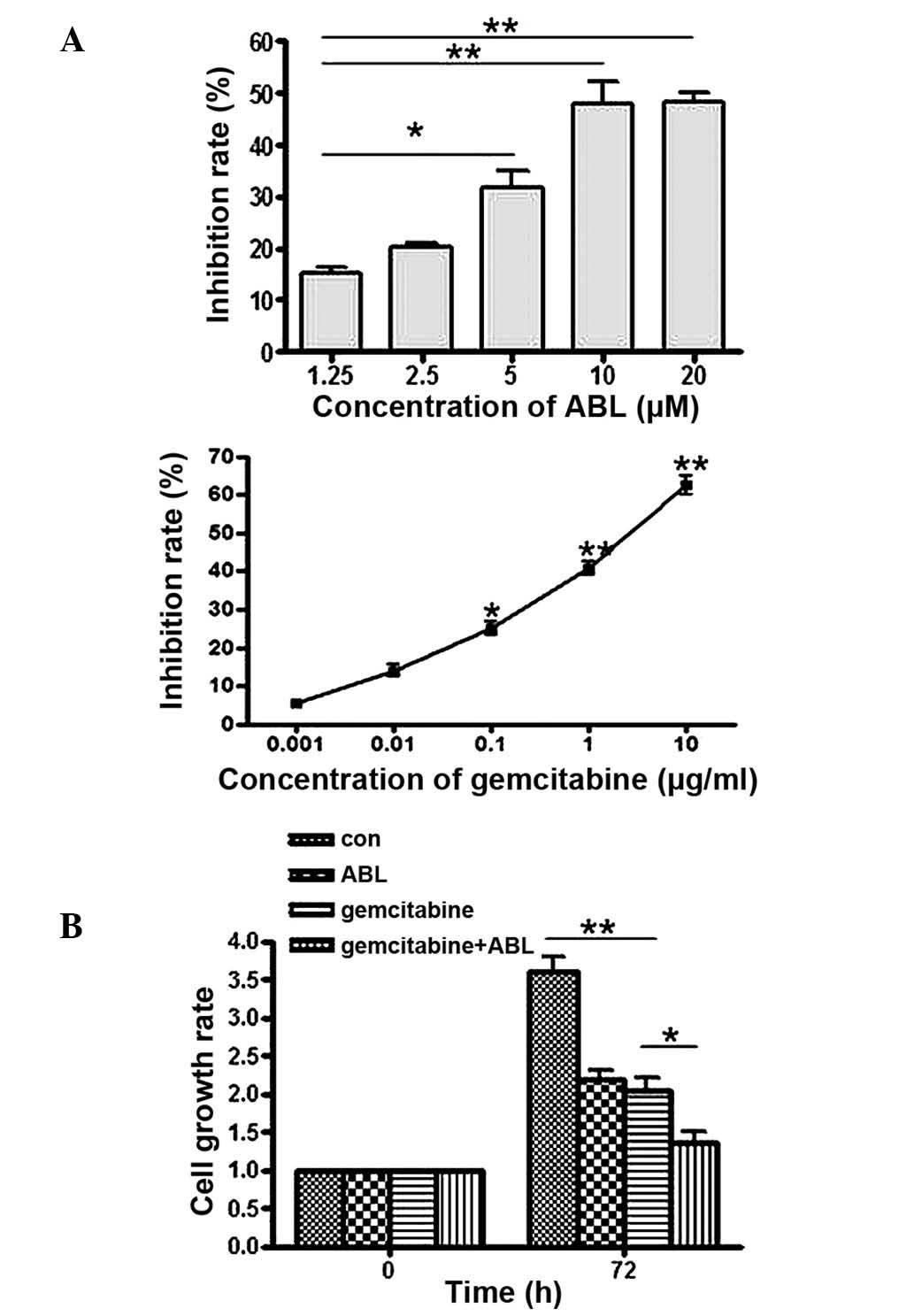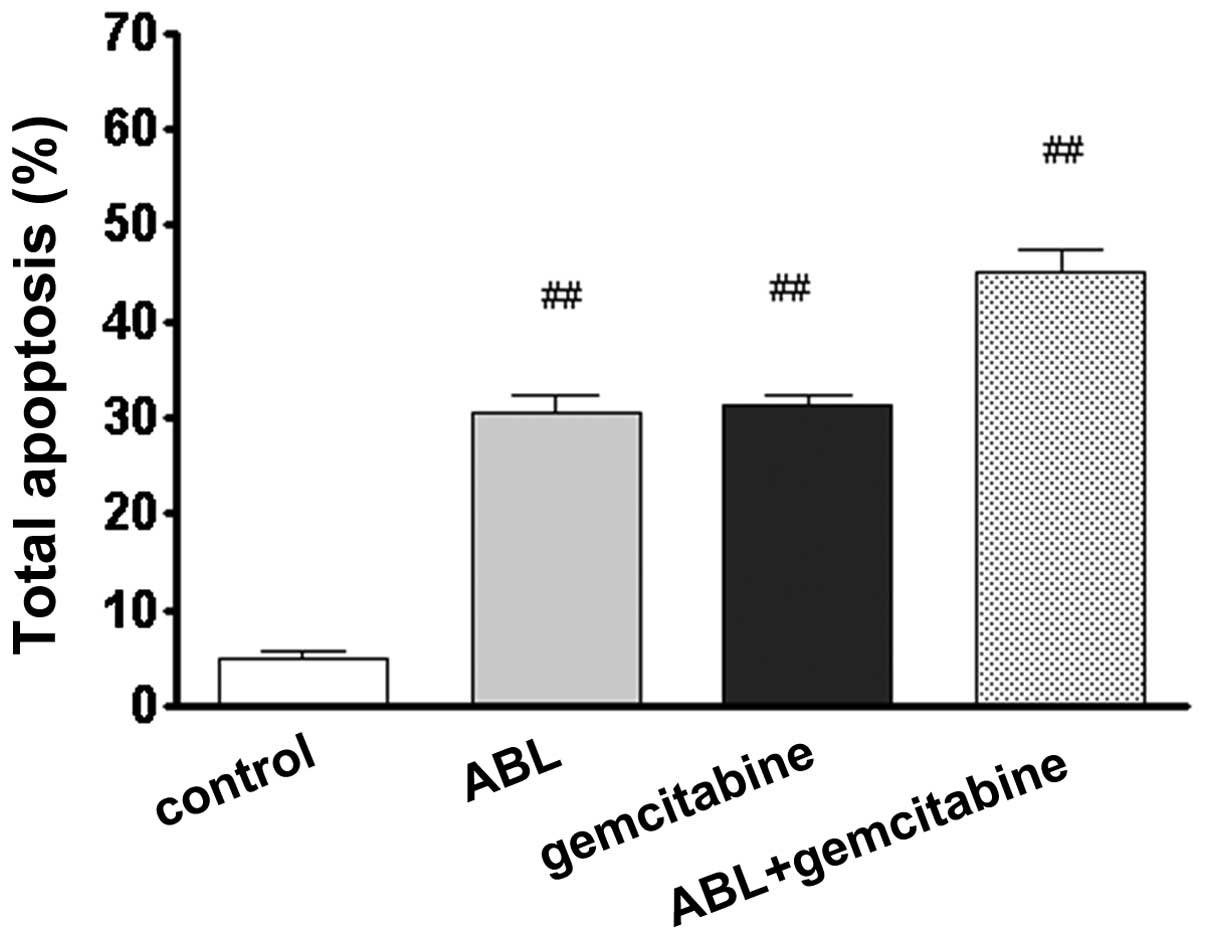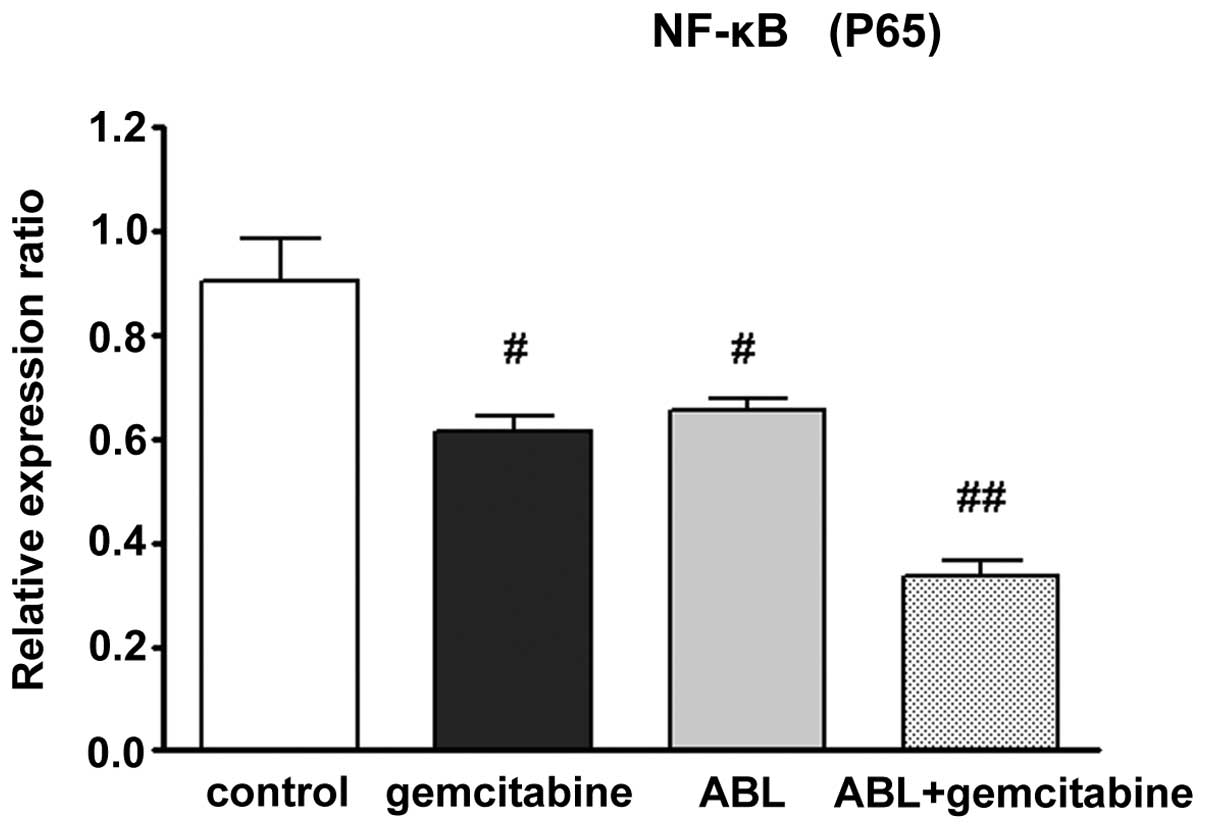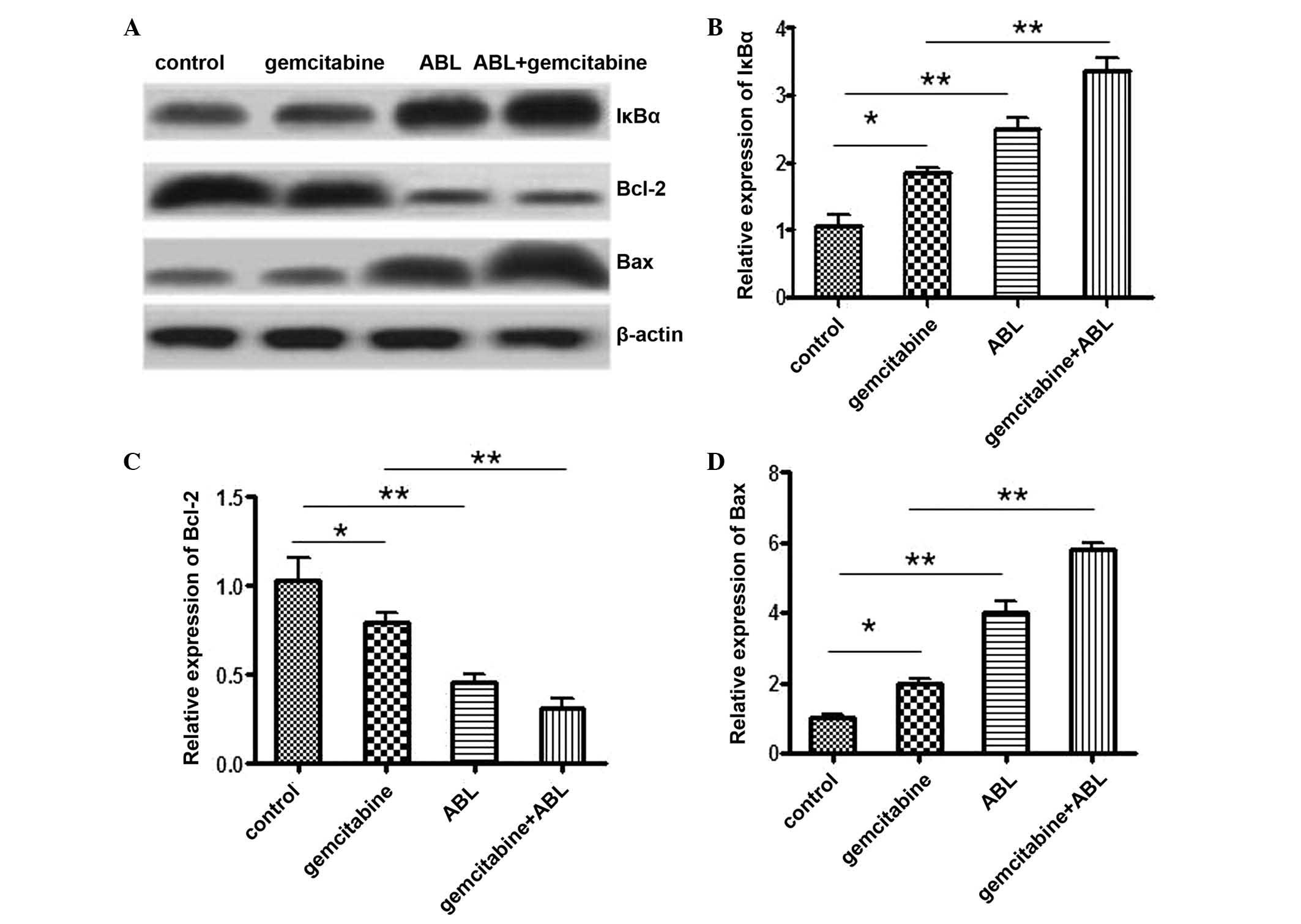1‑O‑acetylbritannilactone combined with gemcitabine elicits growth inhibition and apoptosis in A549 human non‑small cell lung cancer cells
- Authors:
- Published online on: July 3, 2015 https://doi.org/10.3892/mmr.2015.4042
- Pages: 5568-5572
Abstract
Introduction
Lung cancer is the leading cause of cancer-related mortality worldwide. Non-small-cell lung cancer (NSCLC) accounts for ~85% all cases of lung cancer (1,2), and commonly develops resistance to chemotherapy and radiotherapy, often presents at stages too late for surgical intervention, resulting in a five-year survival rate of <15% (3).
In the past three decades, several chemotherapeutic agents (such as platinum, gemcitabine and pemetrexed) and molecular-targeted agents (such as erlotinib and bevacizumab) have been put into clinical trials. Combination chemotherapy is the preferred standard care of patients with advanced NSCLC, as it can improve patient survival (4).
Gemcitabine (2′,2′-difluorodeoxycytidine) is one of the most effective chemotherapeutic agents against NSCLC (5–8). It has been used as a single antitumor agent or in combination with other cytotoxic agents for solid tumor types, including ovarian and pancreatic cancer (9,10).
Inula britannica is a commonly used Chinese traditional herbal medicines and its extracts have been reported to have immunomodulatory (11,12), anti-inflammatory (13) and antitumor activities (14–16). 1-O-acetylbritannilactone (ABL) is an effective chemical component extracted from inula britannica. Previous studies have suggested that ABL has anti-inflammatory (13) and anticancer (17–19) activities, and therefore has the potential to be developed as a chemotherapeutic agent. ABL is able to elicit apoptosis of human breast cancer cells and inhibit the growth of human leukemia cell lines in vitro (17–19). However, the effectiveness of ABL alone or in combination with gemcitabine, one of the first-line chemotherapeutic agents for lung cancer, remains unknown. The present study was conducted to investigate the effect and mechanism of ABL combined with gemcitabine on cell growth and apoptosis in human NSCLC A549 cells in vitro.
Materials and methods
ABL
ABL (purity, >99%) was isolated from Inula britannica-F. var chinensis Regel and the structure of ABL was determined spectroscopically, as has previously been reported (20).
Cell culture
The A549 human NSCLC cell line (American Type Culture Collection, Manassas, VA, USA) was cultured in RPMI-1640 containing 10% fetal calf serum (FCS), 100 U/ml penicillin and 100 µg/ml streptomycin, and maintained in a humidified atmosphere of 95% air and 5% CO2 at 37°C. The cells were passaged to ensure exponential growth.
Cell proliferation assay
The 3-(4,5-dimethylthiazol-2-yl)-2,5- diphenyltetrazolium bromide (MTT; Sigma Chemicals Co., St Louis, MO, USA) assays were performed to evaluate cell growth and viability following treatment with ABL and/or gemcitabine in RPMI-1640 medium containing 10% FCS. The cells were seeded (1×104 cells/well) in 96-well plates at 37°C with 5% CO2 for 72 h. MTT reagent (5 mg/ml) was added to each well and the cells were incubated for an additional 4 h. The reaction was terminated with 150 µl dimethylsulfoxide (Sigma Chemicals Co.,) per well. Absorbance values at 490 nm were determined by using an ELISA reader (Model 680; Bio-Rad, Hercules, CA, USA).
Analysis of cell apoptosis by flow cytometry
The cells were seeded (4×105 cells per well) in 6-well plates in RPMI-1640 medium for 24 h. The medium was removed and cells were washed with phosphate-buffered saline (PBS); ABL and/or gemcitabine was then added. Following 72 h, the cells were detached by 0.02% EDTA and fixed overnight in 70% ice-cold ethanol at 4°C. Prior to flow cytometric analysis, the fixed cells were centrifuged at 1,800 × g for 10 min, washed twice with PBS and resuspended in propidium iodide (PI) staining solution containing 5 µg/ml PI and 200 µg/ml RNase A (Sigma Chemicals Co.). Using a FACScan flow cytometer (FCM-500; Beckman Coulter Inc., Los Angeles, CA, USA), cell apoptosis analysis was performed on 10,000 cells for each sample.
Western blot analysis
The cellular lysates were separated by 10% sodium dodecyl sulfate-polyacrylamide gel electrophoresis and electro-transferred onto nitrocellulose membranes. Following blocking with 5% non-fat milk in TBST (20 mm Tris-buffered saline, 150 mm NaCl, 0.2% Tween-20, pH 7.6), the membranes were incubated with specific anti-nuclear factor (NF)-κB p65, anti-Bcl-2, anti-Bax, anti-inhibitor nuclear factor κBα (IκBα) or anti-β-actin (Santa Cruz Biotechnology, Inc., Santa Cruz, CA, USA) antibodies at room temperature for 2 h, and subsequently with 1:4,000 horseradish peroxidase-conjugated goat anti-mouse secondary antibody (Santa Cruz Biotechnology, Inc.) for 1 h, immunoreactive bands were visualized by enhanced chemiluminescence (Santa Cruz Biotechnology, Inc., Santa Cruz, CA, USA) kit. β-actin (BD Biosciences, San Diego, CA, USA) was used to normalize the quantity of the protein on the blot.
Statistical analysis
Data are presented as the mean ± standard deviation. Differences among the groups were identified by analysis of variance for multiple comparisons, followed by Bonferroni post hoc analysis for the least significant difference. P<0.05 was considered to indicate a statistically significant difference.
Results
Effect of ABL, gemcitabine and their combination on cell growth in A549 cells
To examine the effect of ABL on cell growth, the A549 human non-small-cell lung cancer cell line was treated with increasing concentrations of ABL (1.25–20 µM) for 72 h. As demonstrated in Fig. 1A, the cell growth inhibitory effect of ABL was observed in a dose-dependent manner. The effect on proliferation inhibition reached plateau at 10 µM. The inhibitory effect at 20 µM, 49.5% (P<0.001) was comparable to that at 10 µM. This result indicated that ABL is an effective inhibitor of non-small-cell lung cancer cell growth as a single agent. In another experiment, treatment with ABL was set at 10 µM to ensure the maximal inhibitory effect of this compound. In addition, the effect of gemcitabine (0.001–10 µg/ml) on cell growth was examined in vitro and it was identified that gemcitabine inhibited the proliferation of A549 cells with a strong potency (the inhibitory rate was 62.6% at 10 µM of gemcitabine). Subsequently, the A549 cell lines were co-treated with ABL and gemcitabine. The concentrations of ABL and gemcitabine were 10 µM and 10 µg/ml, respectively, due to the similar inhibitory effect observed at these dosages in the experiment with each individually. The effect of co-treatment with ABL and gemcitabine on cell proliferation was measured by an MTT assay. Following 72 h of treatment, the combination of the two agents enhanced the efficacy significantly (cell survival rate, 30.2%) on the suppression of cell growth compared with the control, ABL alone, or gemcitabine alone (survival rates at 100, 59.1 and 49.7%, respectively; Fig. 1B; P<0.001). The above results demonstrate that ABL inhibited the cell growth in the A549 cell line and this inhibitory effect was further enhanced when used in combination with gemcitabine.
Effect of ABL alone or in combination with gemcitabine, on A549 cell apoptosis in
The inhibitory effect of cell proliferation may be caused by the induction of apoptotic cell death. To elucidate the mechanism underlying this effect, it was investigated whether ABL alone or in combination with gemcitabine induced cell apoptosis and if so, whether the combination leads to an increase in the rate of apoptosis. The A549 cells were treated with ABL (10 µM) alone and in combination with gemcitabine (10 µg/ml). Cell apoptosis was examined by PI staining and FACS analysis. As demonstrated in Fig. 2, <5% of the cells cultured with RPMI-1640 medium were apoptotic and following ABL-treatment at a concentration of 10 µM for 72 h, 30.4% of cells were apop-totic (P<0.05), which was similar to that observed following 10 µg/ml gemcitabine-treatment for 72 h-treatment (31.4% of apoptotic cells). Compared with the single treatment, the combination of ABL and gemcitabine increased the percentage of apoptotic cells (P<0.01). These findings suggest that ABL has the ability to induce cell apoptosis in vitro and this pro-apoptotic effect may also be markedly increased following the addition of gemcitabine.
ABL alone and combined with gemcitabine suppresses NF-κB activation
Next, the present study aimed to investigate the change in the signaling pathway of NF-κB in lung cancer cells, including nuclear p65 levels and transcription of all NF-κB-regulated genes. It was identified that ABL alone resulted in marginal suppression of NF-κB expression (NF-κB p65 protein level) as determined by western blot analysis. When A549 cells were co-cultured with ABL and gemcitabine, the NF-κB expression was also inhibited and the inhibitory rate was notably more potent compared with treatment with ABL alone (Fig. 3).
Treatment with ABL alone and combined with gemcitabine downregulates Bcl-2, upregulates Bax and prevents degradation of IκBα
To investigate the possible mechanism underlying the enhanced cell apoptosis, the expression of IκBα and NF-κB downstream molecules anti-apoptotic Bcl-2 and pro-apoptotic Bax was determined. Western blot analysis (Fig. 4) demonstrated that the expression of Bcl-2 was significantly downregulated in the combination group compared with individual agent treatment group and RPMI-1640 medium control group (P<0.01), while the expression of Bax markedly increased. The expression of IκBα, which is the inhibitory protein of NF-κB activation, was subsequently examined by western blot analysis. Following treatment by ABL alone and in combination with gemcitabine for 72 h, total IκBα expression levels were increased in the two groups.
Discussion
In the last 25 years, there has been an advance in the understanding of the characteristics of lung cancer. However, progress in the treatment of this disease has been more limited and novel therapies are required to reduce the effects of the increasing incidence of lung cancer. In recent years, the natural chemical compounds from various plants have been investigated as potential antitumor drugs. As traditional Chinese medicine has been used for hundreds of years, there has been increasing interest in identifying novel antitumor agents derived from these herbs. ABL is a natural product extracted from inula britannica, which is a commonly used Chinese traditional medicine. This compound has been reported to exhibit anticancer activities in various cell lines in vitro and is able to induce apoptosis of human breast cancer cells and inhibit the growth of human leukemia cell lines (17–19). However, to the best of our knowledge, the effect of ABL in the A549 human non-small lung cancer cell line has not previously been investigated.
Considering that gemcitabine is one of the first-line chemotherapy drugs for NSCLC, the effects of ABL alone and in combination with gemcitabine were investigated in in vitro assays in the present study. The antiproliferative activity was observed in A549 cells in vitro following treatment with ABL alone, gemcitabine alone, and in ABL and gemcitabine in combination. By comparing the results of these three treatment groups, it was observed that there was a synergistic effect on the suppression of proliferation with the combination of ABL and gemcitabine. As it is well established that the inhibitory effect of cell proliferation may be caused by the induction of cell apoptosis, the percentage of apoptotic cells in the treatment groups of ABL alone, gemcitabine alone and in combination was also measured. A similar phenomenon to the cell growth suppression assay was observed; treatment with ABL or gemcitabine alone induced cell apoptosis and the effect was significantly enhanced when the cells were treated by a combination of the two.
The NF-κB pathway is a key regulator of numerous cellular events, including proliferation, differentiation and apoptosis, and it is also associated with tumor development and progression. It has been reported that NF-κB has bidirectional roles (inhibit or promote) in cell apoptosis and the actual role depends on the stimuli applied and the cell line used in the study. Using western blot analysis, it was identified that the activation of NF-κB in A549 cells was suppressed by treatment with ABL, which may have promoted apoptosis in the tumor cells as was observed in the present study. The effect following the combination of ABL and gemcitabine was found to inhibit the activation of NF-κB, which subsequently induced cell apoptosis. Further studies are required to fully understand the underlying apoptotic mechanism of the effects of ABL on A549 cells, including focusing on the apoptosis execution molecules, such as caspase-3 or caspase-8 to determine whether the caspase pathway is involved in this apoptotic effect.
Mature NF-κB P65:P50 dimers are trapped in the cytoplasm of unstimulated cells by interaction with the inhibitory protein, termed IκBα. The IκB kinase (IKK) phosphorylates IκBα proteins, thereby targeting them for rapid ubiquitin-dependent proteolysis that initiates NF-κB activation (21,22). The present study identified that all of the treatments (ABL alone, gemcitabine alone and a combination of the two) were able to upregulate the expression of IκBα in the A549 cells, which maintained the NF-κB dimers sequestered in an inactive state in the cytoplasm and protected the cell from apoptosis. The activation of NF-κB may change the expression of a large number of target genes, including Bcl-2. Bcl-2 family proteins are associated with signal transduction in apoptosis and affect the chemosensitivity of tumor cells to anticancer agents (23). It has been revealed that Bcl-2 and Bcl-xL (anti-apoptotic protein) protect numerous cell lines from apoptosis induction, while Bcl-xS and Bax-α (pro-apoptotic protein) have the opposite effect (24–26). In the present study, the levels of NF-κB downstream molecules Bcl-2 and Bax were measured to examine the possible mechanism underlying the induction of cell apoptosis. The expression of Bcl-2 was significantly downregulated whereas Bax was upregulated in all of the treatment groups compared with the control group, and a synergistic effect was observed following treatment with a combination of the two agents. Several studies have reported that agents that treat lung cancer may induce apoptosis via the Fas/FasL system (27–29). In the present study, the expression of the Fas/FasL system (Fas, soluble and membrane-bound Fas ligand) in A549 cells co-treated with ABL and gemcitabine was also detected. However, there was no significant difference prior to and following the combination treatment. Therefore, it is hypothesized that ABL alone and in combination with gemcitabine may inhibit the NF-κB signaling pathway, which is involved in the cell growth and apoptosis of A549 cells. The increased levels of IκBα may inhibit NF-κB expression and activation, and thus induce cell apoptosis. As a result the anti-apoptotic Bcl-2 gene was downregulated and the proapoptotic Bax protein was upregulated. Therefore, these results suggest that the mechanism underlying the induction of apoptosis by ABL alone and ABL combined with gemcitabine in A549 cells is by decreasing antiapoptotic gene (Bcl-2) and increasing proapoptotic gene (Bax) expression, respectively.
In conclusion, ABL specifically targets the NF-κB pathway and significantly induces apoptosis in A549 human non-small lung cells in vitro. This effect was significantly enhanced when combined with gemcitabine. The present study merits the further investigation of this compound, as it may represent a novel chemotherapeutic agent in lung cancer treatment if this compound has favorable in vivo pharmacokinetic properties.
Acknowledgments
This study was supported by the National Natural Science Foundation of China (grant no. 81170028).
References
|
Jemal A, Siegel R, Ward E, et al: Cancer statistics 2007. CA Cancer J Clin. 57:43–66. 2007. View Article : Google Scholar : PubMed/NCBI | |
|
McCracken M, Olsen M, Chen MS Jr, et al: Cancer incidence, mortality, and associated risk factors among Asian Americans of Chinese, Filipino, Vietnamese, Korean, and Japanese ethnicities. CA Cancer J Clin. 57:190–205. 2007. View Article : Google Scholar : PubMed/NCBI | |
|
Erridge SC, Moller H, Price A and Brewster D: International comparisons of survival from lung cancer: pitfalls and warnings. Nat Clin Pract Oncol. 4:570–577. 2007. View Article : Google Scholar : PubMed/NCBI | |
|
Ramalingam S and Belani C: Systemic chemotherapy for advanced non-small cell lung cancer: recent advances and future directions. Oncologist. 13(Suppl 1): 5–13. 2008. View Article : Google Scholar : PubMed/NCBI | |
|
Laskin JJ and Sandler AB: First-line treatment for advanced non-small-cell lung cancer. Oncology (Williston Park). 19:1671–1676. 2005. | |
|
Langer F, Helsberg K, Schütte WH and Leschinger MI: Gemcitabine in the first line therapy of advanced and metastatic non-small-cell lung carcinoma (NSCLC): review of the results of phase III studies. Onkologie. 28(Suppl 1): 1–28. 2005. | |
|
Cucević B, Samarzija M, Baricević D, et al: Gemcitabine in the first and second-line chemotherapy of advanced non-small cell lung cancer. Coll Antropol. 29:583–588. 2005. | |
|
Natale R: A ten-year review of progress in the treatment of non-small-cell lung cancer with gemcitabine. Lung Cancer. 50:S2–S4. 2005. View Article : Google Scholar : PubMed/NCBI | |
|
Lund B, Hansen OP, Theilade K, Hansen M and Neijit JP: Phase II study of gemcitabine (2′,2′-difluorodeoxycytidine) in previously treated ovarian cancer patients. J Natl Cancer Inst. 86:1530–1533. 1994. View Article : Google Scholar : PubMed/NCBI | |
|
Heinemann V: Gemcitabine: progress in the treatment of pancreatic cancer. Oncology. 60:8–18. 2001. View Article : Google Scholar : PubMed/NCBI | |
|
Lee J, Tae N, Lee JJ, Kim T and Lee JH: Eupatolide inhibits lipopolysaccharide-induced COX-2 and iNOS expression in RAW264.7 cells by inducing proteasomal degradation of TRAF6. Eur J Pharmacol. 636:173–180. 2010. View Article : Google Scholar : PubMed/NCBI | |
|
Jin HZ, Lee D, Lee JH, et al: New sesquiterpene dimers from Inula britannica inhibit NF-kappaB activation and NO and TNF-alpha production in LPS-stimulated RAW264.7 cells. Planta Med. 72:40–45. 2006. View Article : Google Scholar : PubMed/NCBI | |
|
Liu YP, Wen JK, Zheng B, Zhang DQ and Han M: Acetylbritannilactone suppresses lipopolysaccharide-induced vascular smooth muscle cell inflammatory response. Eur J Pharmacol. 577:28–34. 2007. View Article : Google Scholar : PubMed/NCBI | |
|
Rafi MM, Bai NS, Chi-Tang-Ho, et al: A sesquiterpenelactone from Inula britannica induces anti-tumor effects dependent on Bcl-2 phosphorylation. Anticancer Res. 25:313–318. 2005.PubMed/NCBI | |
|
Bai N, Lai CS, He K, et al: Sesquiterpene lactones from Inula britannica and their cytotoxic and apoptotic effects on human cancer cell lines. J Nat Prod. 69:531–535. 2006. View Article : Google Scholar : PubMed/NCBI | |
|
Pan MH, Chiou YS, Cheng AC, et al: Involvement of MAPK, Bcl-2 family, cytochrome c, and caspases in induction of apoptosis by 1,6-O,O-diacetylbritannilactone in human leukemia cells. Mol Nutr Food Res. 51:229–238. 2007. View Article : Google Scholar : PubMed/NCBI | |
|
Liu S, Liu H, Yan W, et al: Studies on 1-O-acetylbritannilactone and its derivative, (2-O-butyloxime-3-phenyl)-propionyl-1- O-acetylbritannilactone ester. Bioorg Med Chem Lett. 14:1101–1104. 2004. View Article : Google Scholar : PubMed/NCBI | |
|
Liu S, Liu H, Yan W, et al: Design, synthesis, and anti-tumor activity of (2-O-alkyloxime-3-phenyl)-propionyl-1-O-acetylbritannilactone esters. Bioorg Med Chem. 15:2783–2789. 2005. View Article : Google Scholar | |
|
Liu B, Han M, Sun RH, et al: ABL-N-induced apoptosis in human breast cancer cells is partially mediated by c-Jun NH2-terminal kinase activation. Breast Cancer Res. 12:R92010. View Article : Google Scholar : PubMed/NCBI | |
|
Wang Y, Shi X, Fu Y, et al: Preparation and determination of 1-O-acetylbritannilactone in Inula Britannica L. Se Pu. 23:573–576. 2005.In Chinese. | |
|
Baltimore D and Beg AA: DNA-binding proteins. A butterfly flutters by. Nature. 373:287–288. 1995. View Article : Google Scholar : PubMed/NCBI | |
|
Gilmore TD, Koedood M, Piffat KA and White DW: Rel/NF-kappaB/IkappaB proteins and cancer. Oncogene. 13:1367–1378. 1996.PubMed/NCBI | |
|
Boise LH, Gottschalk AR, Quintáns J and Thompson CB: Bcl-2 and Bcl-2-related proteins in apoptosis regulation. Curr Top Microbiol Immunol. 200:107–121. 1995.PubMed/NCBI | |
|
Korsmeyer SJ, Shutter JR, Veis DJ, Merry DE and Oltvai ZN: Bcl-2/Bax: a rheostat that regulates an anti-oxidant pathway and cell death. Semin Cancer Biol. 4:327–332. 1993.PubMed/NCBI | |
|
Chao DT and Korsmeyer SJ: BCL-2 family: regulators of cell death. Annu Rev Immunol. 16:395–419. 1998. View Article : Google Scholar : PubMed/NCBI | |
|
Fahy BN, Schlieman MG, Mortenson MM, Virudachalam S and Bold RJ: Targeting BCL-2 overexpression in various human malignancies through NF-κB inhibition by the proteasome inhibitor bortezomib. Cancer Chemother Pharmacol. 56:46–54. 2005. View Article : Google Scholar : PubMed/NCBI | |
|
Rho JK, Choi YJ, Ryoo BY, et al: p53 enhances gefitinib-induced growth inhibition and apoptosis by regulation of Fas in non-small cell lung cancer. Cancer Res. 67:1163–1169. 2007. View Article : Google Scholar : PubMed/NCBI | |
|
Shimizu M, Kondo M, Ito Y, et al: Soluble Fas and Fas ligand provide new information on metastasis and response to chemotherapy in SCLC patients. Cancer Detect Prev. 29:175–180. 2005. View Article : Google Scholar : PubMed/NCBI | |
|
Sun SY, Yue P, Hong WK and Lotan R: Induction of Fas expression and augmentation of Fas/Fas ligand-mediated apoptosis by the synthetic retinoid CD437 in human lung cancer cells. Cancer Res. 60:6537–6543. 2000.PubMed/NCBI |













